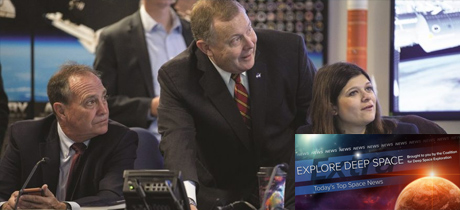In Today’s Deep Space Extra… NASA declares 13 astronaut candidates eligible for flight assignments, following two years of basic training. NASA intern discovers extra solar planet. Astronomers and small satellite operators join to address concerns over reflected light.
Human Space Exploration
NASA’s path to the Moon leads through Congress. Good thing NASA’s No. 2 knows his way around Capitol Hill
SpaceNews.com (1/11): With a lengthy background as a U.S. Senate appropriations staffer and Washington area native, NASA Deputy Administrator Jim Morhard has embraced a strategic role in bringing Congress together behind NASA’s Artemis initiative to achieve an accelerated return to the surface of the Moon with human explorers by 2024.
Dynetics, Sierra Nevada bidding on Artemis lunar lander
Coalition Members in the News – Astrobotic, Boeing, Dynetics, Lockheed Martin, Northrop Grumman
SpaceNews.com (1/10): A team led by Dynetics that includes Sierra Nevada Corporation (SNC) is among the bidders for a NASA program to develop landers that will carry astronauts to the surface of the Moon. In a January 9 conference call with reporters to discuss their company’s plans for the upcoming year, executives with SNC’s space division said the company had joined a team led by Dynetics that submitted a proposal last fall for NASA’s Human Landing System (HLS) program.
NASA graduates new class of astronauts to join Artemis-era missions
Collectspace.com (1/10): On Friday, NASA Administrator Jim Bridenstine hosted ceremonies at NASA’s Johnson Space Center (JSC) marking the completion of basic training for 11 new U.S. astronauts and two astronauts from the Canadian Space Agency. All seven men and six women are now eligible for spaceflight assignments to the Moon under the Artemis initiative as well as the International Space Station (ISS). “They are beginning a journey that will take them on voyages of exploration like humankind has never seen before,” said Mark Geyer, Johnson’s director and co-host of the activities.
One of NASA’s new ‘Turtle’ astronauts may walk on the Moon… or even Mars
Space.com (1/10): NASA’s newest astronauts, five women and six men from the U.S., plus a man and woman from Canada, completed two years of basic training with NASA’s Johnson Space Center (JSC) on Friday. They could be among the first human explorers to return to the surface of the Moon under NASA’s Artemis program and perhaps explore Mars, according to NASA Administrator Jim Bridenstine.
Space Science
A teenager discovered a new planet on the third day of his NASA internship
Washington Post (1/10): Seventeen-year-old Wolf Cukier is credited with the discovery of an extra solar planet just three days into his internship at NASA’s Goddard Space Flight Center. The then high school senior to be’s discovery, TOI 1338 b, is larger than the Earth and orbits two stars. Cukier, of Scarsdale, N.Y., worked with NASA’s Transiting Exoplanet Survey Satellite (TESS) to make the discovery.
Vera Rubin gets a telescope of her own
New York Times (1/11): The significance of Vera Rubin’s contributions to the existence of Dark Matter were significant but long overlooked. Now, her name will grace the newest National Science Foundation observatory, once designated the Large Synoptic Survey Telescope under construction in Chile.
Our galaxy has thousands of alien stars that didn’t come from the Milky Way
Space.com (1/10): A U. S. led research effort points to the presence of stars in the outer reaches of the Milky Way galaxy that appear to have originated within a pair of dwarf galaxies that are likely to be annexed by the Milky Way.
Other News
Why SpaceX’s Starlink satellites caught astronomers off guard
Space.com (1/10): When SpaceX founder Elon Musk outlined plans for a Starlink constellation of small satellites for global broadband in 2015, the plan included about 4,000 small satellites. The forecast is now 12,000 to 30,000 small satellites, compared to the estimated total of 2,000 operational satellites of all types in orbit today. After three launches and 200 Starlink satellites, SpaceX has joined the astronomical community in their surprise at the brightness and how that might detrimentally affect observations. The company is seeking a countermeasure, a topic of discussion at last week’s meeting of the American Astronomical Society in Hawaii.
DoD wants Army, Navy to join Space Force; may ask Hill for help
Breaking Defense (1/10): Soon, the recently established U.S. Space Force will seek authorization from Congress to bring personnel from the Army, Navy and Marine Corps into the Space Force, which is presently organized within the U.S. Air Force.
Independent study of launch market says U.S. Air Force should support three domestic providers
Coalition Members in the News – Northrop Grumman, United Launch Alliance
SpaceNews.com (1/12): An independent study by the Rand Corp, requested by the U.S. Air Force, suggests its mission plans over the next decade could support three heavy lift launch services providers. The USAF plans two providers currently. Rand findings suggest the Air Force consider a third supplier in the short term as a fall back.
Major Space Related Activities for the Week
Major space related activities for the week of January 12-18, 2020
Spacepolicyonline.com (1/12): Scheduled spaceflight activities this week include SpaceX’s in flight abort test on Saturday, with a liftoff from Cape Canaveral Air Force Station, Florida. The launch will be a test of an uncrewed Crew Dragon capsule’s ability to pull away from its Falcon 9 launch vehicle in response to a launch pad or early in flight emergency is a requirement to achieve certification under NASA’s Commercial Crew Program to transport astronauts to and from the International Space Station (ISS). On Wednesday, NASA astronauts Christina Koch and Jessica Meir are to resume efforts to exchange new lithium ion solar power batteries for older nickel hydrogen units with a spacewalk outside the International Space Station (ISS). A second spacewalk by the two astronauts to complete the task is planned for next Monday. NASA’s small bodies assessment group meets in Pasadena, California, this week. The U.S. House and Senate are in session as well.

